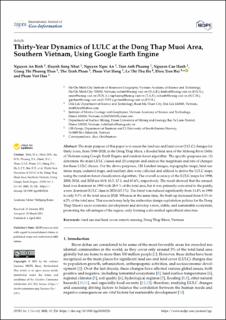| dc.contributor.author | Binh, Nguyen An | |
| dc.contributor.author | Nhut, Huynh Song | |
| dc.contributor.author | An, Nguyen Ngoc | |
| dc.contributor.author | Phuong, Tran Anh | |
| dc.contributor.author | Hanh, Nguyen Cao | |
| dc.contributor.author | Thao, Giang Thi Phuong | |
| dc.contributor.author | Pham, The Trinh | |
| dc.contributor.author | Hong, Pham Viet | |
| dc.contributor.author | Ha, Le Thi Thu | |
| dc.contributor.author | Tien Bui, Dieu | |
| dc.contributor.author | Hoa, Pham Viet | |
| dc.date.accessioned | 2022-04-01T11:46:36Z | |
| dc.date.available | 2022-04-01T11:46:36Z | |
| dc.date.created | 2022-02-04T20:06:15Z | |
| dc.date.issued | 2021 | |
| dc.identifier.citation | Binh, N. A., Nhut, H. S., An, N. N., Phuong, T. A., Hanh, N. C., Thao, G. T., Pham, T. T., Hong, P. V., Ha, L. T., Bui, D. T. & Hoa, P. V. (2021). Thirty-Year Dynamics of LULC at the Dong Thap Muoi Area, Southern Vietnam, Using Google Earth Engine. ISPRS International Journal of Geo-Information, 10(4), Artikkel 226. | en_US |
| dc.identifier.issn | 2220-9964 | |
| dc.identifier.uri | https://hdl.handle.net/11250/2989279 | |
| dc.description.abstract | The main purpose of this paper is to assess the land use and land cover (LULC) changes for thirty years, from 1990–2020, in the Dong Thap Muoi, a flooded land area of the Mekong River Delta of Vietnam using Google Earth Engine and random forest algorithm. The specific purposes are: (1) determine the main LULC classes and (2) compute and analyze the magnitude and rate of changes for these LULC classes. For the above purposes, 128 Landsat images, topographic maps, land use status maps, cadastral maps, and ancillary data were collected and utilized to derive the LULC maps using the random forest classification algorithm. The overall accuracy of the LULC maps for 1990, 2000, 2010, and 2020 are 88.9, 83.5, 87.1, and 85.6%, respectively. The result showed that the unused land was dominant in 1990 with 28.9 % of the total area, but it was primarily converted to the paddy, a new dominant LULC class in 2020 (45.1%). The forest was reduced significantly from 14.4% in 1990 to only 5.5% of the total area in 2020. Whereas at the same time, the built-up increased from 0.3% to 6.2% of the total area. This research may help the authorities design exploitation policies for the Dong Thap Muoi’s socio-economic development and develop a new, stable, and sustainable ecosystem, promoting the advantages of the region, early forming a diversified agricultural structure. | en_US |
| dc.language.iso | eng | en_US |
| dc.relation.uri | https://www.mdpi.com/2220-9964/10/4/226 | |
| dc.rights | Navngivelse 4.0 Internasjonal | * |
| dc.rights.uri | http://creativecommons.org/licenses/by/4.0/deed.no | * |
| dc.title | Thirty-year dynamics of LULC at the dong thap muoi area, Southern Vietnam, using google earth engine | en_US |
| dc.type | Journal article | en_US |
| dc.type | Peer reviewed | en_US |
| dc.description.version | publishedVersion | en_US |
| dc.rights.holder | © 2021 by the authors. | en_US |
| dc.source.volume | 10 | en_US |
| dc.source.journal | ISPRS International Journal of Geo-Information | en_US |
| dc.source.issue | 4 | en_US |
| dc.identifier.doi | https://doi.org/10.3390/ijgi10040226 | |
| dc.identifier.cristin | 1998018 | |
| dc.source.articlenumber | 226 | en_US |
| cristin.ispublished | true | |
| cristin.fulltext | original | |
| cristin.qualitycode | 1 | |

